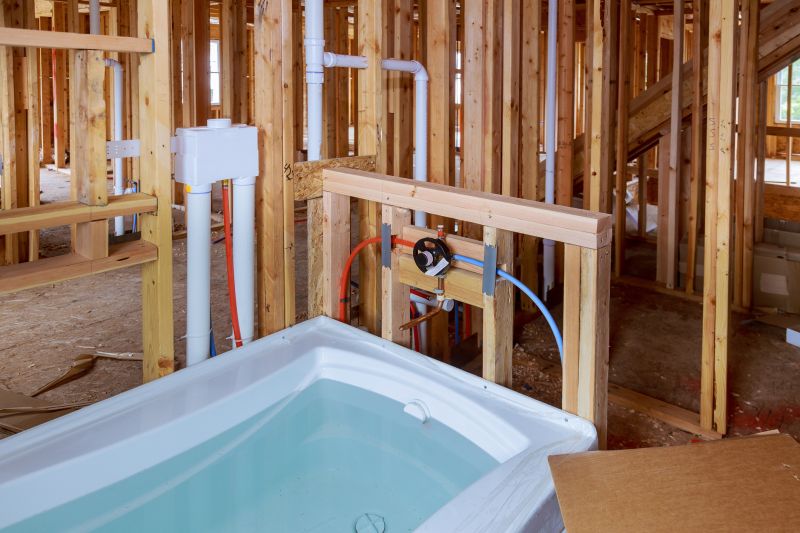Popular Products for Bathtub Installations to Simplify Your Renovation
Browse essential tools and accessories that streamline the bathtub installation process for a professional-looking result.
 Installing a bathtub involves selecting the right products to ensure safety, durability, and ease of maintenance. The process typically starts with choosing a suitable bathtub unit that fits the space and meets user preferences. Bathtubs come in various shapes, sizes, and materials, making it essential to consider the specific needs of the household and the bathroom layout. Once the tub is selected, attention shifts to the supporting components such as faucets, drains, and mounting hardware to achieve a seamless installation.
Installing a bathtub involves selecting the right products to ensure safety, durability, and ease of maintenance. The process typically starts with choosing a suitable bathtub unit that fits the space and meets user preferences. Bathtubs come in various shapes, sizes, and materials, making it essential to consider the specific needs of the household and the bathroom layout. Once the tub is selected, attention shifts to the supporting components such as faucets, drains, and mounting hardware to achieve a seamless installation.
Top Overall Option
Acrylic Bathtub
Acrylic bathtubs are widely appreciated for their lightweight nature, ease of installation, and smooth surface that resists staining and fading. They offer a versatile option suitable for various bathroom styles and are often available in a range of sizes and shapes. Acrylic is also known for its good heat retention, providing a comfortable bathing experience. When selecting an acrylic bathtub, consider the thickness of the material and the included hardware to ensure durability and ease of setup.
Types of Products For Bathtub Installations
Freestanding Bathtubs
Freestanding tubs add a stylish focal point and are easy to install without needing surrounding walls, making them ideal for open-concept bathrooms.
Drop-in Bathtubs
Drop-in tubs are installed into a pre-built deck or surround, offering a customizable look and flexible design options.
Undermount Bathtubs
Undermount installations create a seamless look by mounting the tub beneath a solid surface, facilitating easy cleaning.
Corner Bathtubs
Designed to fit into corner spaces, these tubs maximize bathroom footprint and often include features like jets or ergonomic shapes.
Whirlpool and Jetted Tubs
These tubs incorporate jets for hydrotherapy and relaxation, requiring specialized plumbing and control systems.
Clawfoot Tubs
Classic clawfoot tubs add vintage charm and are typically installed with free-standing plumbing fixtures.
Walk-in Bathtubs
Designed for accessibility, walk-in tubs feature doors for easy entry and are suitable for users with mobility concerns.
Spa and Soaking Tubs
These deep tubs are designed for full-body immersion and relaxation, often with added features like massaging jets.
Vessel Bathtubs
Vessel tubs sit atop the surrounding deck, creating a modern aesthetic with a variety of materials and finishes.
Cast Iron Tubs
Known for durability and heat retention, cast iron tubs require sturdy support and precise installation hardware.
Acrylic and Fiberglass Tubs
Lightweight and easy to install, these materials are popular choices for DIY projects and renovations.
Custom Built-in Tubs
Custom installations allow for tailored designs that integrate seamlessly with unique bathroom layouts.
Popular Choices
Acrylic tubs remain a common choice due to their versatility and ease of maintenance.
Freestanding models are favored for their aesthetic appeal and straightforward installation process.
Drop-in tubs are popular for their customizable surrounds and modern look.
Increasingly chosen for accessibility, walk-in tubs are valued for safety features.
Vessel-style tubs are trending for their contemporary and stylish appearance.
Vintage and classic, clawfoot tubs continue to be popular in traditional bathroom designs.
Hydrotherapy features make jetted tubs a sought-after choice for relaxation.
Corner installation options are favored for maximizing space in smaller bathrooms.
Durability and classic aesthetics keep cast iron tubs in demand among homeowners.
Deep soaking tubs are popular for creating a spa-like experience at home.
Proper installation also requires reliable plumbing fixtures that prevent leaks and facilitate smooth water flow. It is advisable to evaluate the compatibility of these fixtures with existing plumbing systems, especially when upgrading or replacing an old setup. Additionally, accessories like shower curtains, glass enclosures, and grab bars can enhance functionality and safety, especially in households with children or elderly residents.
For those undertaking a bathroom renovation or new construction, professional installation is recommended to ensure compliance with local building codes and standards. However, many homeowners opt for DIY solutions with the right tools and guidance, particularly for simpler setups. Whichever approach is chosen, selecting high-quality, compatible products is key to achieving a lasting and satisfying bathtub installation.
In Redding, CT, residents might focus on products that withstand local climate considerations and fit within their specific bathroom dimensions. Whether upgrading a vintage tub or installing a modern soaking unit, understanding the available options can help in making informed decisions that enhance bathroom functionality and aesthetics.
Key Buying Considerations
- Determine the available space and measure the designated area accurately before selecting a tub.
- Consider the material of the bathtub for durability, maintenance, and aesthetic appeal.
- Evaluate the type of installation—whether freestanding, built-in, drop-in, or corner—to match your bathroom design.
- Check compatibility with existing plumbing fixtures and ensure access to necessary water supply and drainage points.
- Assess the weight of the tub, especially for materials like cast iron, to ensure proper floor support.
- Review the hardware and mounting components included with the product for ease of installation.
- Think about additional features such as jets, ergonomic design, or accessibility options based on user needs.
- Consider the style and finish to match your bathroom decor and personal preferences.
- Research the maintenance requirements of different materials to ensure long-term satisfaction.
- Verify that the product complies with local building codes and safety standards.
- Plan for any additional accessories needed, such as shower enclosures, curtains, or grab bars.
- Budget for the entire installation process, including hardware, fixtures, and potential professional services.
- Read customer reviews and ratings to gauge real-world performance and satisfaction.
- Consult with a professional if unsure about plumbing compatibility or structural support.
